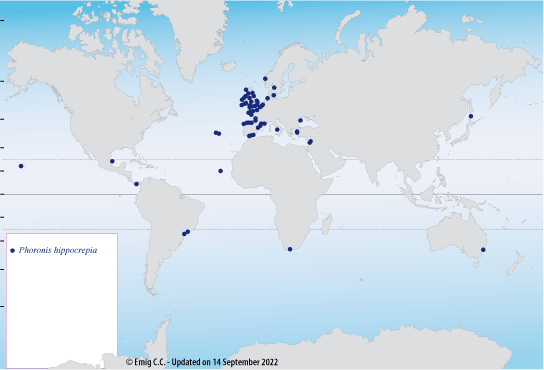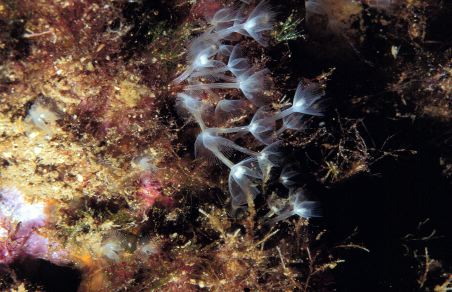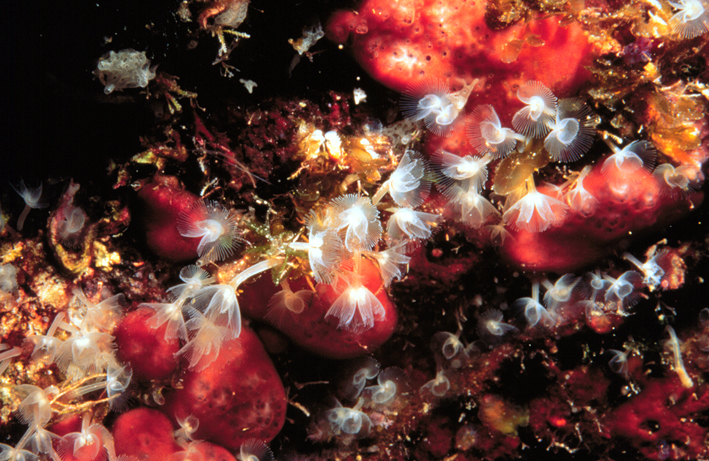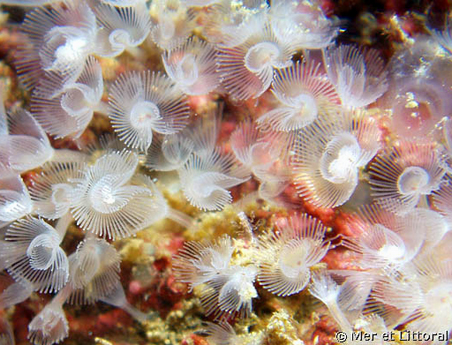|
Phoronis hippocrepia Wright, 1856 Larva: Actinotrocha hippocrepia Silén, 1954 |
|
| Synonyms:
Phoronis (Crepina) gracilis van Beneden, 1858 Phoronis caespitosa Cori, 1889 Phoronis kowalevskii Benham, 1889 Phoronis capensis Gilchrist, 1907
|
|
About the species name hippocrepia: Hippocrepian: from Greek - hippos, a horse, and krépis, a shoe, a sole, means horse-shoe shaped. | |

| Diagnosis | ||||||
|
Last update: Septembre 7, 2006 Extended specimens up to 100 mm long, diameter 0.3-1.5 mm.
Sexual reproduction hermaphroditic; embryos brooded in two masses by the nidamental glands of A type (i.e. on the floor of the lophophoral concavity and on the inner surface of the internal tentacles); small lophophoral organs. Asexual reproduction by transverse fission. Phoronis hippocrepia is a burrowing and encrusting species inhabiting hard substrates i.e. rocks, empty mollusk shells, Caryophyllia (cup-corals), Lithothamnion (crustose coralline algae), wood.
Phoronis hippocrepia: the distribution is represented below on the map. Type-locality: Illfracombe (UK) Last update: September 14, 2022  |

|
Handbook of alien species in Europe (2009) : Comments on the so-called alien phoronid.
Emig C. C., Çinar M. E. & Z. Ergen, 2003. Phoronida from the Eastern Mediterranean and Black Sea. Cahiers de Biologie Marine, 44 (2), 185-190. Breton G. & T. Vincent, 2002. La plongée subaquatique permet-elle d'évaluer de manière fiable la biodiversité de l'épibenthos dans un port ? Bull. Soc. zool. Fr. , 127 (2), 83-94. Emig C. C., Roldán & J. M. Viéitez, 2001. Phoronida. In: European Register of Marine Species, a check list of the marine species in Europe and a bibliography of guides to their identification, Costello M. J., Emblow C. & R. White (eds). Patrimoines Naturels, 50, 324-325.Breton G. & P. Breton, 2001. Flore et faune des ports de La Rochelle (Charente-Maritime). Bulletin de la Société géologique de Normandie et des Amis du Muséum du Havre , 87 (2-3), 87-91. Emig C. C., Roldán C. & J. M. Viéitez, 2000. Foronídeos del litoral luso-español. Phoronida from the Luso-Iberian zone. Boletín de la Real Sociedad Española de Historia Natural (Sec. Biol.), 96 (1-2), 77-83.References on Phoronis hippocrepia
Fig. 1 & 2 - Phoronis hippocrepia on open rock face, 20 m depth - Faial, Azores. Copyright Peter Wirtz. Dr. Peter Wirtz, PO Box 103, P - 9125 Canico, Madeira (Portugal)...
Copyright Mer et Littoral.
|





